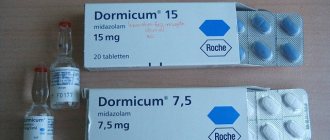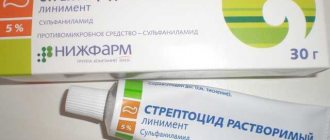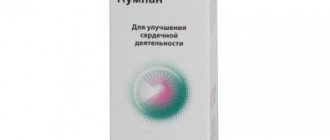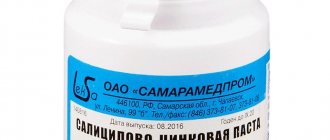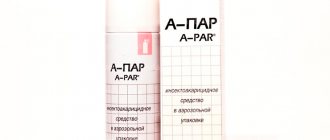Release form, packaging and composition of the drug Clinical-pharmacological group Pharmaco-therapeutic group Pharmacological action Indications for use Method of administration and doses Side effects Contraindications for use Use in children Special instructions Drug interactions
Registration Certificate Holder:
Laboratoires AVENTIS (France)
ATX Code:
R03BC01
Active substance:
cromoglycic acid
Dosage form:
Intal®
| The drug is available with a prescription | Intal® | Aerosol for inhalation. dosed 5 mg/1 dose: vial. 112 doses reg. No.: P N013684/01 dated 03/17/08 - Indefinitely |
pharmachologic effect
Intal is an anti-allergic, anti-inflammatory, anti-asthmatic drug. The active substance of this drug is sodium cromoglycate. When used systematically, it leads to a reduction in the symptoms of allergic inflammation in the respiratory system.
Sodium cromoglycate inhibits both the early and late stages of the allergic reaction, preventing the degranulation of mast cells and the release of inflammatory mediators from them (histamine, bradykinin, slow-reacting substance, leukotrienes, prostaglandins). Thanks to these properties, Intal prevents bronchospasm caused by contact with an allergen or other provoking factor (cold air, physical stress, stress). In addition, it allows you to reduce the intake of other antiasthmatic drugs (bronchodilators, glucocorticosteroids).
The effect of the drug develops gradually. After 4-6 weeks of using Intal, the frequency of bronchial asthma attacks decreases. Treatment should be long-term. If the drug is discontinued, bronchial asthma attacks may recur. The drug is not used to relieve acute attacks of bronchial asthma.
Analogs
The following drugs are produced with the same active ingredient: Allergo-Komod, Vividrin, Ifiral, Krom-allerg, CromoHEXAL, Kromogen, Kromogen Light Breathing, Kromoglin, Cromolyn, Kromosol, Kropoz, Kuzikrom, Lecrolin, Nalkrom, Sodium cromoglycate, Stadaglycin, Thaleum, High -Krom.
According to their belonging to the same pharmacological group, analogues of Intal are the following drugs: Alomid, Daltifen, Zaditen, Zaditen SRO, Ketotifen, Ketof, Pozitan, Rizaben, Staffen, Tailed, Tiled Mint, Frenasma.
Directions for use and doses
Adults (including the elderly) and children
- 2 inhalations 4 times a day.
When the optimal therapeutic effect is achieved, you can switch to a maintenance dose (1 inhalation 4 times a day), which ensures optimal control of the disease. In severe cases, as well as with a high concentration of allergens, the dose of the drug can be increased to 2 inhalations 6-8 times a day.
After achieving a therapeutic effect, you should not suddenly stop using Intal. If necessary, the drug is discontinued gradually over a week. During dose reduction, symptoms of the disease may recur.
An additional dose of the drug can be taken immediately before physical activity to prevent exercise-induced asthma or before contact with suspected allergens.
When concomitant therapy with bronchodilators is used, they must be taken before inhalation of Intal.
In patients receiving corticosteroids, the addition of Intal may allow the dose to be significantly reduced or eliminated entirely.
The basis of effective treatment is the correct use of the inhaler.
The use of the inhaler by children is recommended only under adult supervision.
Using an inhaler
When using for the first time, shake the inhaler and press the metering valve once or twice.
When inhaling, you should adhere to the following instructions:
Remove the dust cap. Inspect the inside and outside of the mouthpiece (tip) to ensure they are clean. Shake the inhaler vigorously. Hold the inhaler upright with your thumb on the base of the canister. Exhale as completely as possible, then insert the mouthpiece into your mouth between your teeth (but without biting it) and close your lips tightly.
Starting to inhale air through your mouth, press the base of the canister so as to spray a dose of Intal; At the same time, continue to breathe calmly and deeply. Hold your breath and remove the inhaler from your mouth. Continue to hold your breath as much as possible.
If you need to immediately administer a second dose of Intal, repeat the procedure. After inhalation, always close the mouthpiece with a dust cap.
special instructions
Intal is intended for the prevention, and not the relief, of attacks of bronchial asthma, so the patient should be warned about the need for regular use of the drug.
If bronchospasm develops, a bronchodilator is prescribed, inhalation of which is done before using Intal.
You can prevent or calm a cough by drinking water immediately after inhalation.
Children should use the inhaler under adult supervision.
Intal allows you to significantly reduce the dose of glucocorticosteroids (GCS), and in some cases even completely abandon their use. The dosage of GCS should be reduced gradually - by 10% per week. If asthma worsens, if an infection develops, as well as with an increased level of antigen in the external environment, an increase in the dose of GCS may again be required.
If it is necessary to stop treatment, it is recommended to discontinue the drug gradually, reducing the dose over the course of a week. However, keep in mind that asthma symptoms may return.
The effect of sodium cromoglycate is enhanced by corticosteroids, beta-agonists and antihistamines.
It is prohibited to inhale Intal in combination with ambroxol and bromhexine.
Side effect
The drug may cause irritation of the upper respiratory tract, dry mouth, unpleasant taste, hoarseness, cough, and short-term bronchospasm. In case of recurring bronchospasm, a bronchodilator is first inhaled, and the cough is calmed by drinking water immediately after inhalation.
As with any inhalation therapy, bronchospasm may unexpectedly develop immediately after inhalation. In this case, you should stop taking the drug and prescribe the patient another treatment.
The above-mentioned adverse events can be reduced by combining Intal with a spacer.
To the rare
Adverse effects include anaphylaxis, headaches and dizziness, painful or difficult urination, frequent urination, nausea and rash.
After discontinuation of the drug, exacerbation of bronchial asthma and eosinophilic infiltration of the lung are possible.
Very rarely
cases of eosinophilic pneumonia have been reported.
Release form and composition
Intal is available in the form of capsules with powder for inhalation and a metered aerosol for inhalation.
The capsules are transparent, hard, gelatinous, consisting of a yellow cap and a colorless body. The contents of the capsules are a homogeneous, almost white powder. Available in blister packs of 10 pieces. 1 sachet contains 1 blister. A cardboard pack contains 3 sachets.
The aerosol after spraying and evaporation is a white powder. Available in 112 doses in aluminum aerosol cans. A cardboard box contains 1 cylinder.
The active ingredient of Intal is sodium cromoglycate.
The auxiliary components in the aerosol are the following substances:
- Hydrofluoroalkane;
- Povidone K30;
- Macrogol 600.
Instructions for Intal (aerosol)
- home
- Instructions for Intal (aerosol)
< Return to previous page
Name: Intal Release form: dosed aerosol for inhalation Dosage: 5 mg/dose 112 doses; INN: Cromoglycic acid ATC code: R03BC01 Group: Drugs for the treatment of diseases of the respiratory system Subgroup: Drugs for the treatment of obstructive diseases of the respiratory tract Pharmaceutical group: Other inhaled drugs for the treatment of obstructive diseases of the respiratory tract Pharmaceutical subgroup: Antiallergic drugs (excluding glucocorticosteroids)
Characteristics: Release form, composition Intal aerosol for inhalation, dosed (after spraying and evaporation of the propellant it is a white powder). 1 dose: - sodium cromoglycate 5 mg Excipients: povidone K30, macrogol (polyethylene glycol) 600, hydrofluoroalkane (HFA-227). Pharmaceutical group: antiallergic agent - stabilizer of mast cell membranes. Pharmaceutical action: Intal is an anti-allergic, anti-inflammatory, anti-asthmatic drug. The active substance of this drug is sodium cromoglycate. When used systematically, it leads to a reduction in the symptoms of allergic inflammation in the respiratory system. Sodium cromoglycate inhibits both the early and late stages of the allergic reaction, preventing the degranulation of mast cells and the release of inflammatory mediators from them (histamine, bradykinin, slow-reacting substance, leukotrienes, prostaglandins). Thanks to these properties, Intal prevents bronchospasm caused by contact with an allergen or other provoking factor (cold air, physical stress, stress). In addition, it allows you to reduce the intake of other antiasthmatic drugs (bronchodilators, glucocorticosteroids). The effect of the drug develops gradually. After 4-6 weeks of using Intal, the frequency of bronchial asthma attacks decreases. Treatment should be long-term. If the drug is discontinued, bronchial asthma attacks may recur. The drug is not used to relieve acute attacks of bronchial asthma. Pharmacokinetics: After administration by inhalation, the maximum concentration of sodium cromoglycate is reached after approximately 15 minutes. Sodium cromoglycate is poorly absorbed from the gastrointestinal tract. Only 8% of the administered dose undergoes systemic absorption. T1/2 is 46-99 minutes (on average about 80 minutes). Sodium cromoglycate is not metabolized. It is excreted unchanged from the body with urine and bile in approximately equal quantities. The rest of the drug is excreted from the lungs with a current of exhaled air or settles on the walls of the oropharynx, then swallowed (without significant absorption - less than 2%) and excreted from the body through the digestive tract. Indications: - preventive treatment of bronchial asthma (including exercise asthma) in children and adults. Category of action on the fetus: The drug Intal should not be prescribed to women in the first trimester of pregnancy. Sodium cromoglicate can be prescribed by a doctor only when the expected benefit to a pregnant or lactating woman outweighs the possible risk to the fetus or infant. Contraindications: - children under 5 years of age; - hypersensitivity to any components of the drug Intal. The drug should be used with caution to treat patients with impaired renal and liver function. It should be under constant medical supervision (it is advisable to reduce the dose). If eosinophilic pneumonia occurs, the drug should be discontinued. Dosage: Adults (including the elderly) and children - 2 inhalations 4 times a day. When the optimal therapeutic effect is achieved, you can switch to a maintenance dose (1 inhalation 4 times a day), which ensures optimal control of the disease. In severe cases, as well as with a high concentration of allergens, the dose of the drug can be increased to 2 inhalations 6-8 times a day. After achieving a therapeutic effect, you should not suddenly stop using Intal. If necessary, the drug is discontinued gradually over a week. During dose reduction, symptoms of the disease may recur. An additional dose of the drug can be taken immediately before physical activity to prevent exercise-induced asthma or before contact with suspected allergens. When concomitant therapy with bronchodilators is used, they must be taken before inhalation of Intal. In patients receiving corticosteroids, the addition of Intal may allow the dose to be significantly reduced or eliminated entirely. The basis of effective treatment is the correct use of the inhaler. The use of the inhaler by children is recommended only under adult supervision. Using the inhaler: When using for the first time, shake the inhaler and press the metering valve once or twice. When inhaling, adhere to the following instructions: Remove the dust cap. Inspect the inside and outside of the mouthpiece (tip) to ensure they are clean. Shake the inhaler vigorously. Hold the inhaler upright with your thumb on the base of the canister. Exhale as completely as possible, then insert the mouthpiece into your mouth between your teeth (but without biting it) and close your lips tightly. Starting to inhale air through your mouth, press the base of the canister so as to spray a dose of Intal; At the same time, continue to breathe calmly and deeply. Hold your breath and remove the inhaler from your mouth. Continue to hold your breath as much as possible. If you need to immediately administer a second dose of Intal, repeat the procedure. After inhalation, always close the mouthpiece with a dust cap. Side effects: The drug can cause irritation of the upper respiratory tract, dry mouth, unpleasant taste, hoarseness, cough, short-term bronchospasm. In case of recurring bronchospasm, a bronchodilator is first inhaled, and the cough is calmed by drinking water immediately after inhalation. As with any inhalation therapy, bronchospasm may unexpectedly develop immediately after inhalation. In this case, you should stop taking the drug and prescribe the patient another treatment. The above-mentioned adverse events can be reduced by combining Intal with a spacer. Rare side effects include anaphylaxis, headaches and dizziness, painful or difficult urination, frequent urination, nausea and rash. After discontinuation of the drug, exacerbation of bronchial asthma and eosinophilic infiltration of the lung are possible. Very rarely, cases of eosinophilic pneumonia have been reported. Overdose: Sodium cromoglycate has low toxicity, so the risk of overdose and the development of any toxic phenomena is small. Interaction: Sodium cromoglycate can be used in combination with bronchodilators and glucocorticosteroids. Special instructions: The drug is not used to relieve bronchospasm. When concomitantly treated with bronchodilators, they must be taken before inhalation of Intal. The maintenance dose of glucocorticosteroids can usually be reduced, and in some cases completely canceled. When reducing the dose of glucocorticosteroids, the patient should be under close medical supervision: the rate of dose reduction should not exceed 10% per week.
< Return to previous page
Reviews about Intal
There are various reviews about Intal on forums and specialized medical websites. Some patients describe it as an effective treatment for bronchial asthma, which is well tolerated and does not cause adverse reactions. Others complain of a lack of effect or the development of adverse events. Many note that the drug is effective, but the symptoms of the disease quickly return after its discontinuation, so treatment must be constant.
There are messages in which users compare capsules and aerosol, noting the high effectiveness and excellent tolerability of capsules, and very much regret that Intal is no longer sold in this dosage form.
Disadvantages include the bitter taste of the drug and the relatively high cost.
Pharmacokinetics
Absorption from the respiratory tract into the systemic circulation after inhalation of the powder is 5%-15% of the dose taken, and absorption from the mucous membranes of the respiratory tract occurs quite quickly, but may decrease with an increase in the amount of secretion.
Sodium cromoglycate is rapidly cleared from the systemic circulation, and therefore subsequent doses taken in accordance with the recommended dosage regimen do not accumulate.
Sodium cromoglycate is reversibly bound to plasma proteins (approximately 65%) and is not metabolized.
Excretion occurs unchanged in urine and bile in approximately equal proportions. T1/2 averages about 80 minutes. The rest is excreted through the lungs with exhaled air or settles on the walls of the oropharynx, then swallowed and excreted through the intestines.
Contraindications
The use of Intal is contraindicated in cases of hypersensitivity to the active component or to other substances included in the composition.
Capsules should not be taken by children under 2 years of age or in the first trimester of pregnancy. The aerosol is contraindicated in children under 5 years of age.
Capsules should be used with caution during pregnancy in the second and third trimesters, as well as during breastfeeding.
Intal should be used in the treatment of patients with impaired liver and kidney function only under the supervision of a physician.
